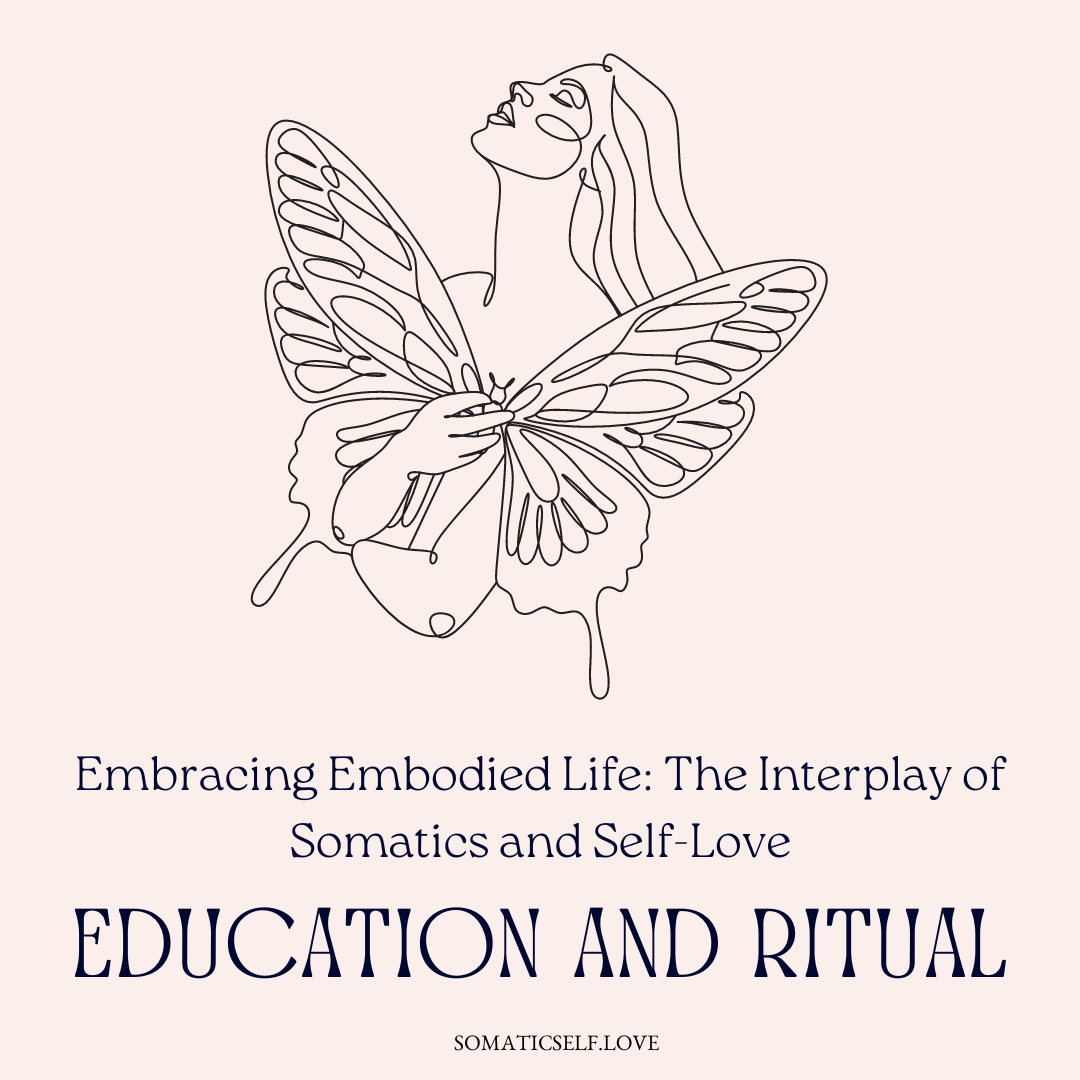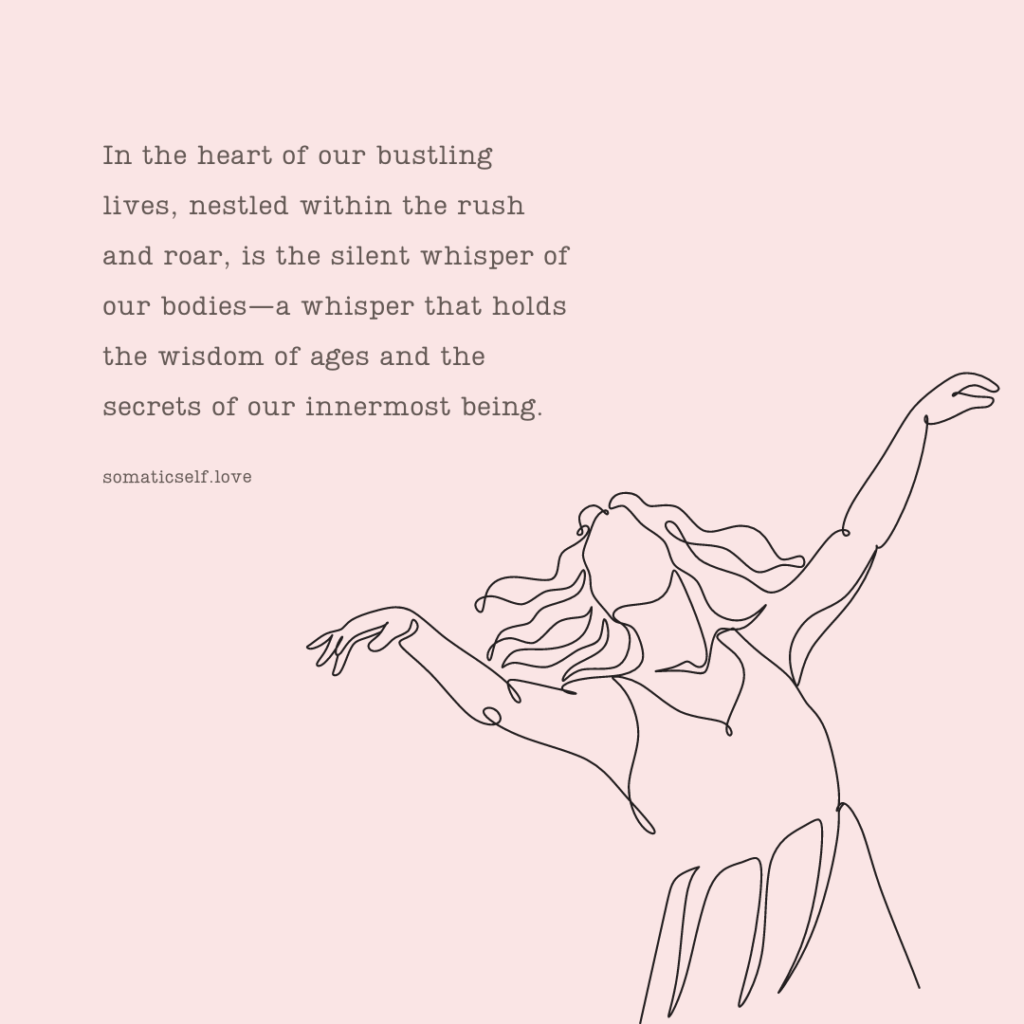Embracing Embodied Life: The Interplay of Somatics and Self-Love

In the heart of our bustling lives, nestled within the rush and roar, is the silent whisper of our bodies—a whisper that holds the wisdom of ages and the secrets of our innermost being. The practice of somatics shines a light on this voice, guiding us towards a deeper, more embodied way of living. But how does this align with the nurturing practice of self-love?
The Embodied Life
At its core, somatics is about immersion into our bodily experiences. As research has consistently shown, our body is not just a vessel but a living library of our histories, emotions, and reactions.* Our life’s habits, traumas, joys, and survival strategies find their imprints in our bodily rhythms and sensations.
Disrupting Reactionary Patterns
Life has a way of molding us into patterns—patterns of reaction based on past experiences and traumas. Often, these aren’t choices but reflexes conditioned over time. However, by tuning into our felt senses, we can decipher these patterns. The felt sense offers a direct line to our nervous system, allowing us to interrupt and recalibrate our reactions. It’s akin to rewriting a story while being acutely aware of its plot. Instead of being at the mercy of our habitual responses, we learn to respond in alignment with our true values and desires.

Reconnecting with the Web of Life
One of the profound revelations of somatics is its reminder of our innate humanity and interconnection. In an age where objectification and environmental detachment are rampant, we’ve developed a knack for dissociation. We numb ourselves to avoid the pain of disconnection or the discomfort of others’ sufferings. This detachment, as unfortunate as it may sound, allows for continued apathy toward environmental and social issues.
Somatics offers a counter-narrative. By deeply feeling and perceiving our own senses, we revive our empathy. This renewed sense of connection doesn’t just stop at our skin—it radiates outward, reminding us of our profound link to others, to nature, and to the delicate web of life that binds us all.
The Dance of Somatic Self-Love
Marrying the practices of somatics with self-love offers a potent pathway to self-awareness and growth. It invites us into a dance where every step is an act of understanding, every twirl a celebration of connection, and every pause a moment of introspective clarity. By opening to our own senses, we not only nurture ourselves but also remember our shared human journey—steeped in empathy, understanding, and interdependence.
In the journey of somatic self-love, we don’t just find ourselves; we find our place in the grand tapestry of existence.
Somatic Symphony: A Ritual of Embodied Self-Love
Embark on a journey of embodied self-discovery and nurture the deep connection between your mind, body, and soul. This somatic self-love ritual, inspired by the synthesis of somatics and self-love, is designed to ground you, reawaken your senses, and help you build a nurturing relationship with your body.
1. Setting the Tone:
- Choose a quiet, comfortable space where you won’t be disturbed.
- Dim the lights or use soft lighting like candles to create a warm, inviting ambiance.
- Play gentle, ambient music or nature sounds to enhance your sensory experience.
2. Grounding Breathwork:
- Sit or lie down comfortably.
- Close your eyes and take five deep, intentional breaths. Feel the air as it enters and exits your nostrils or mouth.
- Visualize roots growing from your body into the Earth, connecting you with its core.
3. Body Scan Meditation:
- Beginning at your toes, slowly scan each part of your body.
- Acknowledge any sensations or emotions that arise. Do not judge or try to change them; simply observe.
- As you move up your body, release any tension you find, melting into the ground beneath you.
4. Felt Sense Exploration:
- Focus on any sensations that arise, be it warmth, tingling, tightness, or coolness.
- Instead of analyzing these sensations, just be with them. They are messengers from your body, bearing tales of your experiences, reactions, and emotions.
- Offer gratitude to your body for communicating with you.
5. Dance of Expression:
- Stand up and allow your body to move in any way it feels called to.
- Let this movement be spontaneous. It might be slow swaying, energetic jumping, or anything in-between.
- Feel the liberation as your body tells its story through movement.
6. Reconnection Affirmations:
- Sit down again, placing one hand over your heart and the other on your belly.
- Recite the following affirmations, feeling each word resonate within you:
- “I am deeply connected to my body.”
- “I honor the wisdom it offers me.”
- “My senses are doorways to deeper understanding and empathy.”
- “I am part of the vast web of life, interwoven and interdependent.”
7. Reflective Journaling:
- Take a journal and pen.
- Write down any sensations, emotions, or insights that arose during the ritual. This is your body’s language, and journaling can help decode its messages.
8. Gratitude & Closure:
- Close your ritual by expressing gratitude to your body for its resilience, wisdom, and constant communication.
- Drink a glass of water, visualizing it as nourishment, reaching every cell, rejuvenating you.
Repeat this ritual weekly or as often as you feel called to. Remember, the goal is to cultivate a deep relationship with your body, understanding its language, and nurturing it with love and care.
Research
*Van der Kolk, B. (2014). The Body Keeps the Score: Brain, Mind, and Body in the Healing of Trauma. Viking.
This work by Dr. Bessel van der Kolk dives into how trauma affects the body and mind, and how the body retains the imprints of traumatic experiences. It offers a comprehensive overview of how our bodies store memories of trauma and how they can be unlocked and processed for healing. He suggests that by paying attention to our body’s sensations and movements, we can tap into these stored memories and begin the process of understanding and healing.
(Note: This is a real book and is highly respected in the field of trauma research. However, if you’re looking for a peer-reviewed scientific article, you may need to access specific databases to extract more detailed, empirical studies on the subject.)